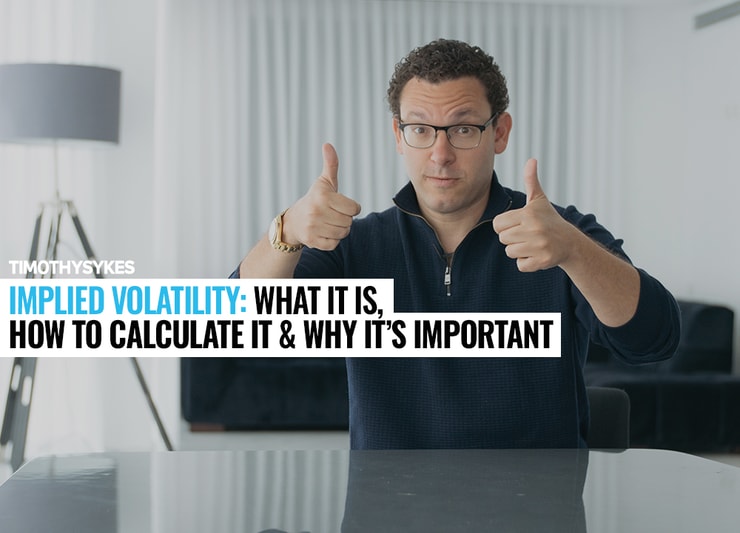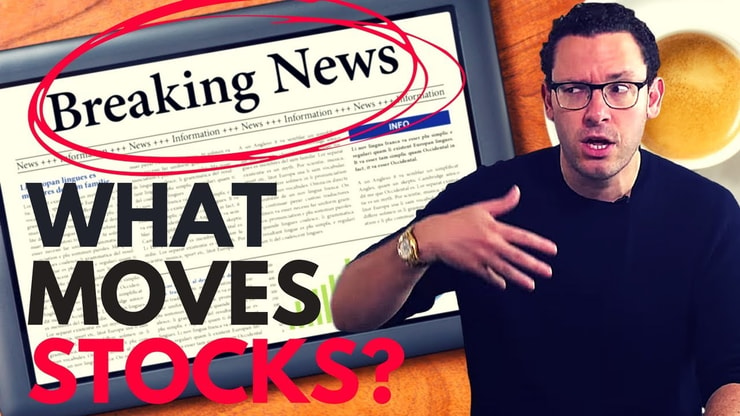There’s no crystal ball that can predict the future in trading, but there are tools you can use to make educated guesses about a security’s performance in the future.
One tool is implied volatility, a calculation that can give you insight as to how a stock’s volatility might change over time.
Implied volatility is largely associated with options trading, but you can use this valuable indicator with any type of security. In this post, I’ll introduce you to implied volatility, including how it’s calculated, the benefits of using it, and important considerations you must keep in mind.
Table of Contents
What Is Implied Volatility?

To understand implied volatility, let’s break down both parts of the phrase.
If you hit up the dictionary, you’ll find that implied means “involved, indicated, or suggested without being directly or explicitly stated; tacitly understood.”
In trading, volatility has its own meaning. It refers to the speed of a stock’s price movement. Volatility is how fast a stock’s price moves up or down. The quicker it moves, the higher the volatility.
When you mash them together, implied volatility means the estimated or assumed volatility of a stock’s price in the future.
Why Is Implied Volatility Important?
Options traders are particularly interested in calculating the average implied volatility.
Wait … what’s an option? Let’s take a quick sidebar.
Options are a type of derivative, which is a type of security with a value that’s based on an underlying asset or a series of assets. These might include bonds, commodities, stocks, currencies, and market indexes.
Derivatives can be traded like stocks, either on the OTC markets or one of the big exchanges. The prices will fluctuate based on the underlying asset’s value.
Because the price of an option is based on the underlying price of the asset, it’s considered a derivative. However, what differentiates options from other types of derivatives is the type of underlying asset in question.
With options, you’re basically calling dibs on the purchase of an asset, but only if it reaches a specific price.
An options contract is where you establish an agreement for the ability to purchase the asset at an agreed-upon price at or before a certain date. However, you have until that day to decide, and you can ultimately decline if it doesn’t reach your price or if you change your mind.
That’s why they’re called options — you have the option to go for it or walk away. Just in case you’re getting confused about the difference between options and futures, here’s the key difference …
With futures, you have the right to buy the security, but you’re obligated to do so if it reaches your specified criteria. Unlike with options, you can’t just back out.
Implied Volatility and Options
Implied volatility is a big part of determining the price of an option.
Because you can’t know how volatile a stock will be in the future, implied volatility is used to try to predict that and roll it into the price.
If the level of implied volatility is high, the option might have higher premiums. The opposite is true, too: If the implied volatility is quite low, the option might be lower in price.
Implied volatility helps in determining an option’s future value and in setting an appropriate and ideally fair price.
Critical point here: Implied volatility cannot and will not ever be totally accurate. That’s because it’s based on probability rather than fact. You can’t know the future. It’s an educated projection, yes. But it’s a still a projection — not an absolute.
Implied volatility can also have an impact on securities that aren’t options. For instance, it’s frequently used in determining an interest rate cap (a cap on how much an interest rate can increase over time).
Benefits of This Stock Indicator
Traders look at implied volatility when researching stocks for a slew of reasons. Here are just a few of the benefits:
- Indication of the market’s temperature. The implied volatility can clue you in on the overall condition and mood of the stock market. As a general rule, implied volatility will be greater during a bear market. That’s because the general mood is that stocks will probably decrease. A bull market is associated with a lower implied volatility — the general consensus is that the prices will increase over time. Bottom line: The assumption is that implied volatility is higher during a riskier (bear) market and lower during a more optimistic (bull) market.
- Project the security’s future movement. Implied volatility is often used as a means of understanding what a security might do in the future based on a number of factors. Ultimately, all of the above things are ways of trying to figure out what a stock might do. Implied volatility can help you better predict big price swings for a stock or option. For example, a high implied volatility can suggest a big price swing. A low volatility, on the other hand, can tell you that there probably won’t be any big swings in price. There’s a caveat, though. Implied volatility doesn’t necessarily tell you which way the price will move. So a high implied volatility can suggest a big price swing, but it doesn’t necessarily tell you if it will go up or down.
- Educated decisions for trades. As you know, I’m all about historical data in my research. I believe that every trader should consider a stock’s historical price action and chart history. You can’t possibly know precisely what the future will hold, but your research can help you more accurately predict what’s possible in the future. Of course, it’s important to remember that implied volatility is probability based. It’s an estimate, not a set-in-stone indication. Nonetheless, it can give you a leg up on a potential trade and help you make better-educated decisions.
Implied Volatility vs. Historical Volatility
Implied volatility can be (and often is) confused with historical volatility, so let’s discuss the difference.
Historical volatility, also referred to as realized volatility or statistical volatility, is based on historical data like prior price action. So it’s based on actual documentation of the stock’s past performance.
Implied volatility considers the past but is ultimately forward-looking. It considers the past as a means to predict what might happen to a stock’s price or volatility in the future.
How to Calculate Implied Volatility
So, how can you calculate the implied volatility for a stock or security? Here’s the lowdown on how it works.
Black-Scholes Volatility
The Black-Scholes formula or model was developed in 1973 by three economists: Black, Scholes, and Merton. (It’s also sometimes called the Black-Scholes-Merton formula.) It’s used to calculate the theoretical price of options and acts as a sort of implied volatility calculator.
The development of this formula led to a huge growth in options trading. It was so popular, in fact, that in 1997 the creators won the Nobel Prize in economics for their achievement.
Implied Volatility Formula
Let’s look at how the Black-Scholes formula works …
The equation involves the market price, the price of the underlying asset, the option’s ‘strike price,’ the option’s expiration, and the interest rate.
Good news, you don’t have to work it out yourself: a good stock screener will include an implied volatility indicator that you can refer to.
Like any other predictor, though, the Black-Scholes model is not infallible. The accent is on ‘implied,’ meaning it makes assumptions that might not play out. One is that the model accounts for constant volatility. Seasoned traders know this isn’t always the case … prices don’t constantly move in a highly volatile way, even with so-called volatile stocks.
The Binomial Model
Another method for determining implied volatility is the binomial model.
This model uses a tree-style diagram that factors in volatility at multiple levels. It shows the many ways it could branch off price-wise. Then, it goes backward to determine what seems like a reasonable average.
A lot of traders like this model. They can go back to it for an early exercise, where they exercise an option before it expires.
This model is only available with American options, though. Plus, it takes longer to calculate this model, so you gotta plan ahead. You don’t want to try cram this in an hour before the markets open, for instance.
How to Trade Implied Volatility
How can you factor implied volatility into your trading? Here are some implied volatility trading strategies and things to consider:
Where to Find Implied Volatility of a Stock
Before you can use implied volatility as part of your trading strategy, you need to know where to locate it. Guess where that is … yep, on a good stock screener.
Stock Screener
Many stock trading platforms and programs only have rudimentary tools for looking at stock indicators and information.
That’s fine for basic research, but if you want to really refine your trading, you need refined tools. A high-quality stock screener like StocksToTrade can help you with the most indicators, and that includes implied volatility.
You’ll mostly look for implied volatility on options trades. On a stock trading platform or screener, you’ll see it listed as “vol,” as the Roman numeral four (IV), or the Greek sigma symbol (σ).
Supply and Demand
Supply and demand have a direct influence on the implied volatility of an asset. How?
If the demand increases, so will the expectations for the stock price. And with this, implied volatility can rise. That can lead to high prices for premiums on options.
But if demand decreases, there’s too much supply. The share price won’t be met with such high expectations. Implied volatility will be lowered, which can lead to cheaper options prices.
Time Value
How long is the period specified in the option? This is referred to as the time value, and it can have a big effect on the implied volatility.
Here’s why: Say an option has a date that isn’t too far in the future. The implied volatility will likely be pretty low since there’s less time to factor into the unknown.
Now, an option with a date way out in the future will typically have a higher implied volatility. There’s more time for things to happen that can affect the volatility.
So why does this matter? Because the level of implied volatility plays a big role in the option’s pricing. Obviously, this can have a big effect on potential profits.
Tips When Following Stock Indicators
The following tips will help you make the most of the implied volatility indicator in your trading.
#1 Choose the Ones That Perform Better
To make the most of implied volatility or any stock indicator, you need to use the best tools to find which securities are likely to perform better.
This is another reason why a stock screener is so important. Not only can it clue you in on the implied volatility, but it can offer plenty of other invaluable information to round out your research, including:
Chart Patterns
As my Trading Challenge students are keenly aware, I’m a big believer in the power of stock charts.
Charts can help you find securities with the most potential. You can use charts to analyze the price action of a stock in various time frames — minutes, days, weeks, months, or even years.
By looking performance during different time frames, you can gain insight into the performance over time!
This can help you make sense of implied volatility. It can also help you determine if a trade is right for you, based on historical data. You want to make smarter trades, right? You have to look at the price-action trends.
News Catalysts
No research is complete without looking at news catalysts. So when you’re looking at a security, ask yourself: Does the implied volatility seem appropriate?
That’s when you check out potential news catalysts. What might happen in the future to affect a stock’s volatility? Look for news specific to the company and the industry, as well as world news that can rock the whole market.
Some stock screeners can be your news aids, pulling headlines related to the security and post them right on the trading page. Social media can even be helpful here, alerting you to rumblings before they hit the headlines.
Stock Indicators
Implied volatility is not a stand-alone indicator. So to make the most sense of it, combine it with other indicators.
Every trader will develop a list of their go-to indicators. Ready to learn more? In my Penny Stocks 101 guide, I offer an introduction to technical indicators. I even go into detail on a few of my favorites.
#2 Stick to Your Trading Plan
Indicators like implied volatility are infinitely more useful when you make and stick to a trading plan.
In an ideal world, we’d all trade like machines: fact-based and emotionless. But in the real world, we’re just human. So it helps to have a way to help you stay accountable. Your trading plan is that vehicle.
A trading plan is simple. It’s a written plan where you detail your course of action for trades.
The plan should be the culmination of careful research. It should lay out why you’re making the trade, why it’s a good idea, and what specifically you hope to gain from it. Based on your research, you set entry and exit points as well as your stop loss (whether mental or real).
While your trading plan doesn’t have to follow a specific format, I suggest that you actually write it down. That way you’re more likely to stick with it when push comes to shove. Remember, your trading plan is your system of checks and balances. You put in place to help you stay responsible and level-headed.
Over time, trading plans can have a powerful impact on your trading. You can use them to review past trades, so don’t throw them away! It’s part of how you figure out what’s working in your trading and what’s not.
Use this knowledge to refine setups and continue to improve.
#3 Master Your Skills With Seasoned Mentors
Every trader wants to be knowledgeable and self-sufficient. Just like almost anything else, that’s easier said than done.
On my trading journey, I learned things the hard way. I didn’t have a mentor, so I learned by trial and error. There were many ups … and many downs. Looking back, if I’d had a mentor, I could have avoided a lot of mistakes.
Personally, I think it’s BS that new traders don’t have a ton of great resources. But I don’t resign myself to that fact, so I created the resource I wish I’d had with my Trading Challenge.
In my Challenge, I act as a mentor and guide to my students. And if you join the Challenge, I’ll help guide you through the basics — there are just certain things every trader needs to know.
But my bigger goal is to help you think for yourself as a trader so that you can enjoy a long and independent career.*
I try to balance teaching with letting you discover your own style as a trader. I keep you informed with live trading and Q&A webinars every week. I also like to show by doing, so you’ll get to see me and my top students at work. You can learn from our good plays and our bad ones too.
With continued study and practice, you’ll begin to learn market methods. And you can learn to leverage those methods in ways that best suit your personal trading goals — risk tolerance, style, budget, and more.
The Bottom Line
There are plenty of unknowns in trading, so there’s a lot of value in employing indicators to help you better guess a security’s future movement.
I know … technical indicators aren’t the sexiest topic. But what you get out of knowing them and putting them to good use in your trades? That’s beyond exciting!
If you want to know how a security might perform in the future, you need to understand and look at Implied volatility. Don’t overlook this informative indicator!
But just like any other indicator, implied volatility is only a piece of the puzzle. It should never be the one factor on which you make final decisions. Definitely use it part of your thorough research before executing any trade, though.
How do you use implied volatility in your trades? How does it factor into your research? Leave a comment and let me know!





Leave a reply